The Profound Symbolism of Sapphire Stone
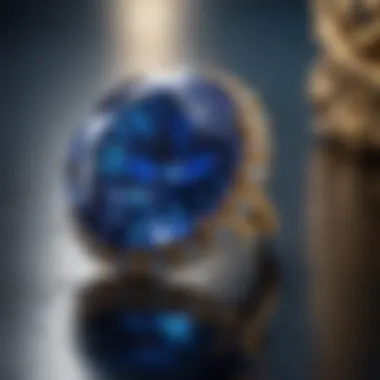
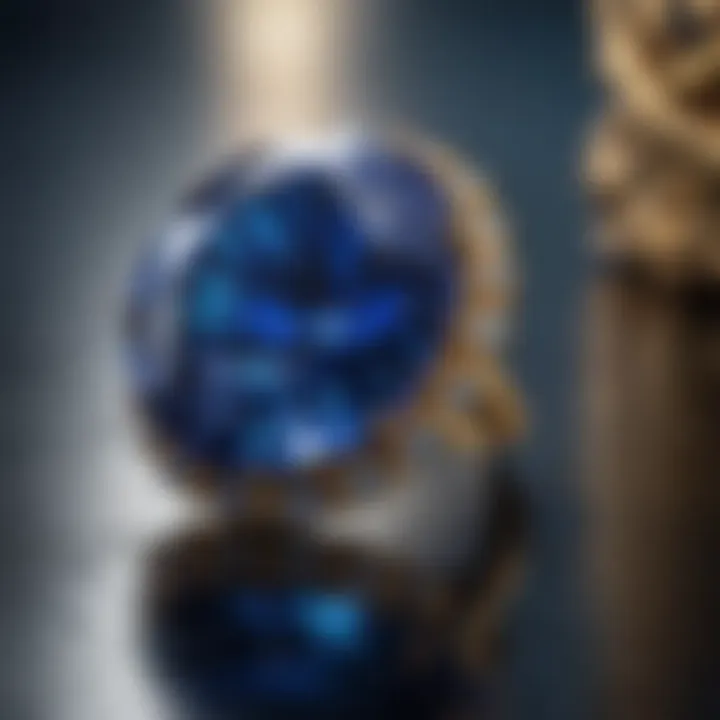
Intro
The sapphire stone has fascinated humanity for centuries. Much more than a mere gemstone, it carries a rich tapestry of meanings that span across cultures and epochs. From its brilliant blue hue to the significant roles it has played in royal assemblies, sapphires evoke a sense of allure and mystery. Understanding this gemstone requires a dive into its definition, characteristics, and how it has been perceived throughout history.
Gemstone Overview
Definition and Characteristics
Sapphire is a variety of the mineral corundum, which primarily consists of aluminum oxide. The stone is most known for its deep blue color, though it can also be found in a variety of shades, including yellow, green, orange, and even colorless varieties. This wide spectrum arises from trace elements like iron and titanium. The hardness of sapphire, rated at a 9 on the Mohs hardness scale, makes it one of the most durable gemstones, suitable for daily wear in jewelry.
Classification of Gemstones
Sapphires can be classified in different ways, including by color, origin, and treatments. The most prized sapphires are often considered those that exhibit a strong and vibrant royal blue hue, known as "cornflower blue."
- Natural Sapphires: These stones are mined directly from the earth without any enhancements.
- Synthetic Sapphires: Created in laboratories, these stones have the same chemical properties as natural sapphires.
- Treated Sapphires: Many sapphires undergo treatments to enhance their color and clarity, which is important to understand for buyers.
Properties of Gemstones
Physical Properties
The physical properties of sapphires contribute significantly to their desirability. The stone exhibits exceptional clarity, brilliance, and luster. Its specific gravity ranges from 3.95 to 4.03, which is indicative of its density. Sapphires can also display a phenomenon known as asterism, where a star-like pattern appears when viewed under certain lighting conditions, enhancing the stone's appeal.
Chemical Properties
The chemical structure of sapphire allows it to withstand various environmental elements. As mentioned, it is primarily composed of aluminum and oxygen. The presence of other minerals leads to variations in color, a key property of sapphires. For instance, the presence of iron can cause yellow sapphires, while chromium gives rise to the red varieties, which are classified as rubies rather than sapphires. Understanding these chemical properties is vital for anyone interested in exploring the deeper meanings and applications of this precious stone.
"Sapphire represents wisdom, loyalty, and nobility, making it a gemstone with a historical significance beyond its visual beauty."
Overall, sapphires maintain a deep-seated reverence in various cultures and histories. As we proceed in this exploration, we will delve into the broader implications, both cultural and metaphysical, that this gemstone embodies.
Preamble to Sapphire
Sapphire has captivated humanity for centuries with its rich history and remarkable beauty. It holds a unique place in the gemstone world, recognized not only for its aesthetic appeal but also for its significance across various cultures. The sapphire stone represents protection, wisdom, and royalty, making it a powerful symbol throughout history.
In this section, we will explore the importance of sapphire, setting the stage for a deeper understanding of its numerous attributes. This examination goes beyond mere appearance. It encompasses the emotional connections people have with this gemstone and its impact on different spheres of life.
Overview of the Sapphire Stone
The sapphire stone is typically blue, but it can come in a variety of colors, excluding red, which is classified as ruby. This versatility makes it a favorite among collectors and jewelry designers alike. Sapphires are highly prized for their vivid colors, durability, and brilliance.
In the realm of geology, sapphires are a form of corundum, which is an aluminum oxide mineral. Their formation occurs deep within the Earth’s crust under immense pressure and heat. This natural creation process contributes to their unique characteristics and helps explain their value in both fine jewelry and other applications.
Sapphires are often linked to the Chakras and are believed to enhance mental clarity and promote emotional balance. Many individuals turn to sapphires for their psychological benefits, adding to the reasons for their popularity.
"The sapphire is more than just a gemstone. It is a portent of wisdom, virtue, and nobility."
Physical Characteristics of Sapphire
Understanding the physical characteristics of sapphire is vital for several reasons. First, these characteristics help distinguish the sapphire from other gemstones. Second, they contribute to the overall value and desirability of the stone. A thorough knowledge of these elements allows gemstone enthusiasts, collectors, and jewelry designers to make more informed choices.
Chemical Composition
The chemical composition of sapphire primarily consists of aluminum oxide (Al2O3) in its crystalline form. This composition is crucial because it contributes to sapphire's unique properties, including its vibrant colors and durability. Trace elements, such as iron, titanium, and chromium, can influence the stone's color and appearance. For instance, the presence of titanium and iron typically results in blue sapphires, while chromium is responsible for creating the rich red hues found in rubies, which are part of the same family.
Color Variations
Color is perhaps the most striking characteristic of sapphire. Although many people associate sapphires with the color blue, they actually come in a variety of colors, including yellow, pink, green, and even colorless. This range occurs due to the different trace elements present in the stone.
- Blue Sapphire - Most recognized for its deep, rich blue hues.
- Pink Sapphire - Often more valuable than its blue counterpart, depending on saturation.
- Yellow Sapphire - Features a variety of yellow hues, often with a golden tint.
- Star Sapphire - A type that exhibits a star-like phenomenon, creating a unique optical effect.


This diversity enhances the stone's appeal, making it a versatile choice for jewelry.
Durability and Hardness
Sapphire is known for its exceptional durability. It ranks a 9 on the Mohs scale of mineral hardness, making it one of the hardest gemstones. This hardness comes from its strong, tightly packed crystal structure. Due to this durability, sapphires are well-suited for everyday wear, especially in rings and bracelets.
In addition to hardness, sapphires are also resistant to scratching, making them an excellent choice for items that require longevity and resilience. However, it is important to note that while sapphires are durable, they can still be susceptible to chipping or breakage when subjected to severe impact or stress.
"The beauty of sapphire lies not only in its color but also in its remarkable resilience and strength."
In summary, the physical characteristics of sapphire—its chemical makeup, color variations, and durability—play a pivotal role in its significance. This section provides essential insights into why sapphire holds such a revered place in both the gemstone market and cultural contexts.
Historical Significance
Sapphire holds a prominent position in the tapestry of human history. Its significance extends beyond mere aesthetics; it embodies deeper meanings and reflects the values and traditions of various cultures. Throughout time, sapphire has been admired not only for its beauty but also for its purported powers and its connections to royalty and spirituality. In this section, we will delve into two key aspects of sapphire's historical significance: its presence in antiquity and its role in the spheres of royalty and power.
Sapphire in Antiquity
In ancient civilizations, sapphire was not just a gemstone; it was a symbol. The earliest records of sapphire usage date back to the ancient Persians who believed that the heavens were the color of the stone. For them, it was a bridge between Earth and the celestial realm. Ancient Greeks and Romans associated it with Apollo, the god of light and prophecy. Hence, they wore it for protection and guidance.
Moreover, in Asia, particularly in India, sapphires have been revered since ancient times. They were part of the sacred texts and were often included in royal gems. It was believed that the stone protected its wearer from envy and harm. Individuals of high status wore sapphire to signify purity, wisdom, and nobility.
Artifacts from these ancient times show that sapphire was often intricately carved. These carvings narrated stories and symbolized beliefs prevalent at the time. The craftsmanship and artistry reflect the high regard in which this stone was held.
Role in Royalty and Power
The sapphire's association with royalty is palpable throughout history. Monarchs have adorned themselves with exquisite sapphire pieces, signifying authority and respect. Royal families across cultures valued sapphires. For instance, the British royal family has a rich collection of sapphires, most notably the Cambridge Sapphire, which is set in a brooch originally gifted to Queen Victoria. Such pieces are not merely jewelry; they convey stories of power and heritage.
The stone's deep blue hue has often been associated with the divine, thus making it a popular choice for crowns and other royal adornments. It was believed that sapphires would bestow divine favor upon the ruler.
"Sapphire has woven its history into the fabric of our civilization, transcending its role as a gemstone to become a symbol of wisdom, power, and protection."
In summary, the historical significance of sapphire is multifaceted. From its revered status in antiquity to its enduring symbolism in royalty and power, sapphire remains a captivating subject for scholars and enthusiasts alike.
Cultural Importance
The cultural importance of sapphire evokes a rich tapestry of meanings and interpretations across various societies. This significance is not static but evolves over time, influenced by historical context, mythology, and contemporary beliefs. Understanding the cultural impact of sapphire deepens our appreciation for this remarkable gemstone, revealing layers of meaning that resonate on both personal and collective levels.
Symbolism of Love and Wisdom
Sapphire is often associated with love and wisdom, elevating its status beyond mere beauty. In numerous cultures, it symbolizes faithfulness and sincerity. The deep blue hue represents the depth of human emotion and the clarity of thought. For example, in the Middle Ages, sapphires were believed to attract heavenly favor. Today, many couples choose sapphires for engagement rings, seeing it as a stone that promises a future filled with wisdom and everlasting love.
- Love: The symbolism of sapphire in romantic contexts represents loyalty and devotion. Many cultures believe that gifting a sapphire ensures lasting love.
- Wisdom: Historically, sapphires were often worn by rulers and scholars alike. The thought was that the stone would enhance mental clarity and decision-making abilities.
Additionally, the stone’s connection to wisdom extends into modern interpretations. Considered a stone of insight and truth, sapphires are seen as tools for mental focus and clarity. It enhances communication, guiding individuals toward making wise choices in their lives.
Sapphire in Religion and Spirituality
Sapphire has a notable place in various religious and spiritual contexts. Many faiths associate the stone with divine protection and enlightenment. For instance, in Christianity, sapphires are linked to the heavens and grace. They are often found in sacred texts and artifacts. Similarly, in Hinduism, sapphires are linked to the planet Saturn, believed to bring peace and prosperity.
- Spiritual Insight: Many people believe that sapphires can aid in meditation, providing a pathway to spiritual understanding.
- Symbol of Purity: The blue color is often associated with purity and divine favor, making it a common choice in religious artifacts and jewelry.
The influence of sapphire extends far beyond mere adornment. It serves as a reminder of the spiritual and ethereal realms, guiding individuals through their personal spiritual journeys. Exploring its role in various religious traditions reveals how deeply embedded sapphire is in the human experience, serving as a bridge between the material and spiritual worlds.
Geographic Origins
The geographic origins of sapphires are crucial to understanding their significance and the differences among various stones. Each region produces sapphires with unique characteristics, influenced by local geological conditions. Generally, sapphires are formed in metamorphic rocks, where high temperatures and pressures create the conditions necessary for their development. Exploring these origins allows enthusiasts to appreciate the stone's rare beauty and intrinsic value.
Major Sapphire Producing Countries
Some key countries known for sapphire production included:
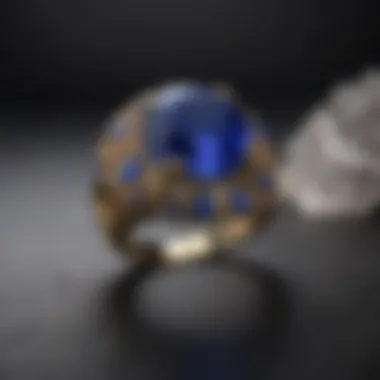
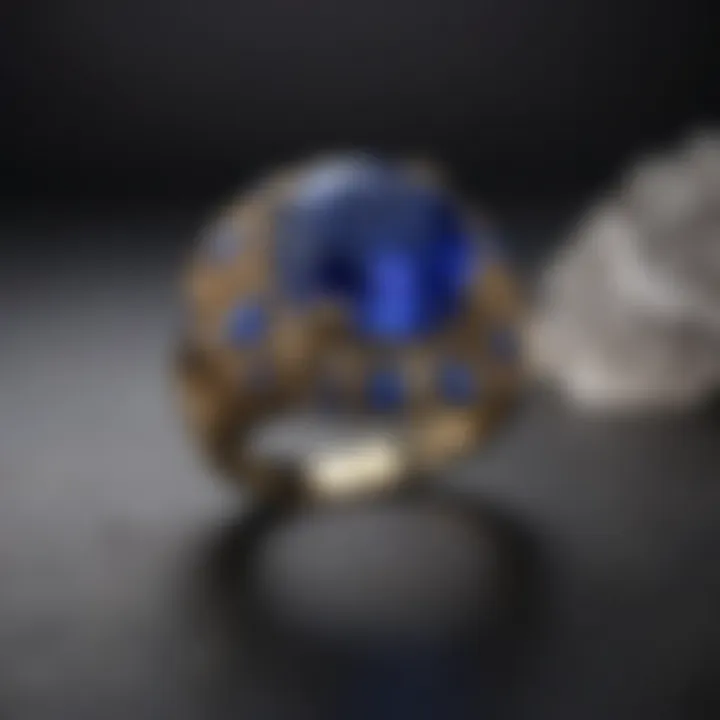
- Sri Lanka: Often called the "Island of Gems," Sri Lanka is famous for its deep blue sapphires, along with a variety of color treatments. The country has a long history of sapphire mining, drawing gem aficionados worldwide.
- Myanmar: Known for its exceptional quality, Myanmar produces highly sought-after sapphires. The Mogok region is particularly notable for rich blue and vibrant pink stones. Issues of political instability can impact mining practices and gem quality.
- Thailand: Regional mining has shifted in Thailand towards more treated stones. This shift has changed the perception of the gemstones produced here, as many buyers prefer untreated varieties.
- Australia: Australia is home to the most significant sapphire deposits. It often yields darker stones, with a unique quality known as the "Australian Blue".
- Montana, USA: Known for its distinctive color palette, Montanan sapphires come in blue, yellow, and even pastel hues. They are less common globally but prized for their authenticity.
The origins affect not just the colors, but also the lore and value associated with each stone. Collectors often seek sapphires from specific countries due to these unique traits.
Mining Practices and Ethical Sourcing
Ethical sourcing is an essential aspect of the sapphire market today. Many consumers now seek to purchase sapphires that have been mined responsibly. Some mining practices can have devastating effects on local communities and environments.
A few considerations for ethical mining include the following:
- Environmental Impact: Sustainable mining practices help reduce land damage and ensure ecosystems remain intact. Companies employing responsible methods emphasize reclamation, restoring land to its natural state after mining.
- Community Welfare: Ethical sourcing involves ensuring fair labor practices and investing in local communities. Supporting artisans and ensuring fair wages can help uplift regions dependent on mining.
- Certification: Organizations and initiatives exist to certify gemstones as ethically sourced. Buyers should seek these certifications when purchasing sapphires, particularly vintage or antique pieces.
"Choosing ethically sourced sapphires contributes to a positive impact on communities and ecosystems full of history and artistry."
Overall, being aware of the geographic origins and mining practices around sapphires can contribute to a more informed, conscientious approach for both collectors and consumers. It is not only about acquiring a beautiful gem but also ensuring that the gemstone's journey respects both people and the planet.
Metaphysical Properties
The metaphysical properties of the sapphire stone play a significant role in understanding its deeper meaning and appeal. Many believe that sapphires possess unique energies that can influence mental and emotional states. The gemstone is often associated with wisdom, royalty, and nobility. This connection extends beyond its physical beauty, engaging those interested in its psychological and healing benefits.
Psychological Effects
Sapphire is thought to have calming effects on the mind. Many enthusiasts report feelings of serenity and tranquility when they are around sapphire. This impact is vital for individuals seeking to enhance their mental clarity and emotional stability. It is said that wearing sapphire can aid in the dissemination of negative thoughts and can foster a sense of inner peace. Some studies even suggest that specific colors of sapphire might amplify these effects, with blue sapphires being particularly noted for this property.
Additionally, the act of embracing the sapphire can assist in opening the mind to higher expressions of oneself. This process is attributed to the link that sapphire has with the third eye and throat chakras, offering support for communication and intuition. As a result, individuals might find it easier to articulate their thoughts and emotions with clarity and confidence.
Healing Properties of Sapphire
Sapphire is also associated with various healing properties, both physical and emotional. Traditional beliefs suggest that sapphires can alleviate ailments related to the throat, particularly those affecting communication, such as sore throats or speech difficulties. In our contemporary context, many still affirm that the gemstone balances the body's energy fields, promoting overall well-being.
Furthermore, the sapphire is believed to assist in the healing of psychological scars, providing support to those grappling with depression or anxiety. It encourages a return to emotional balance. Some practitioners utilize sapphire in alternative healing methods, believing its energies can help release toxins from the body as well as nurture physical healing in general.
"Sapphire is more than a beautiful gemstone; it is a vessel of emotional support and healing for many who incorporate it into their lives."
Ultimately, sapphire's metaphysical properties serve as a fascinating intersection of culture, spirituality, and individual experience. By understanding these aspects, gemstone enthusiasts can cultivate a greater appreciation for not just the stone's aesthetics but its potential implications on the mind and spirit.
Popular Uses of Sapphire
Sapphire is cherished for various reasons, particularly its versatility across different fields. The discussions below illuminate its significance in both aesthetics and function, thereby enhancing our understanding of its applications.
Sapphire in Jewelry Making
Sapphire has earned its place as a premier gemstone in jewelry making. Renowned for its vibrant colors and durability, it appeals to both jewelers and consumers alike. The stone is often cut into various shapes like rounds, princess cuts, and cushions. This allows for creative freedom in design.
One primary reason for its popularity is the hardness of sapphire, rated 9 on the Mohs scale. This ensures that the gemstone is not only beautiful but also sturdy enough for everyday wear. Its resistance to scratches means a sapphire ring or pendant maintains its luster over time. Retail experiences showcase how this durability appeals to couples seeking engagement rings. The stone's historical ties to royalty also add a layer of charm; wearing sapphire can evoke feelings of prestige.
Additionally, consumers have options with sapphire varieties. For instance, the blue sapphire is an enduring classic, but shades like pink, yellow, and even green have seen increased popularity. Jewelers can customize pieces, adding both personal touch and intricate craftsmanship, enhancing the buyer's connection with the gemstone.
"Sapphire's unique allure transcends mere aesthetics; it embodies a blend of beauty and resilience that is unmatched by most gemstones."
Applications in Technology
Beyond the realm of jewelry, sapphire has found its way into numerous technological applications. One of the most notable uses is in the production of watch crystals. Sapphire glass, produced synthetically, is known for its superior optical clarity and scratch resistance. This makes it an excellent choice for high-end timepieces.
Sapphire substrates are also crucial in the electronics industry. They are used in manufacturing blue and white LEDs as well as in high-powered laser diodes. The material's thermal conductivity and resistance to high temperatures make it ideal for these applications. Moreover, the use of sapphire in mobile phone screens is becoming more common, offering users a durable alternative to traditional glass screens.
Both in consumer electronics and industrial applications, sapphire's unique properties continue to drive innovation. Whether it be in a piece of jewelry or a cutting-edge technological device, sapphire's role remains significant and multifaceted.
Sapphire in Literature and Arts
The sapphire stone has long been a source of inspiration in literature and the arts. Its rich hues and captivating beauty have made it a symbol for deep and complex ideas. Writers and artists have turned to sapphire not merely for its physical characteristics, but for the meanings and emotions it evokes. This section delves into how sapphires are represented in various art forms, and how they find a place in poetry and prose.

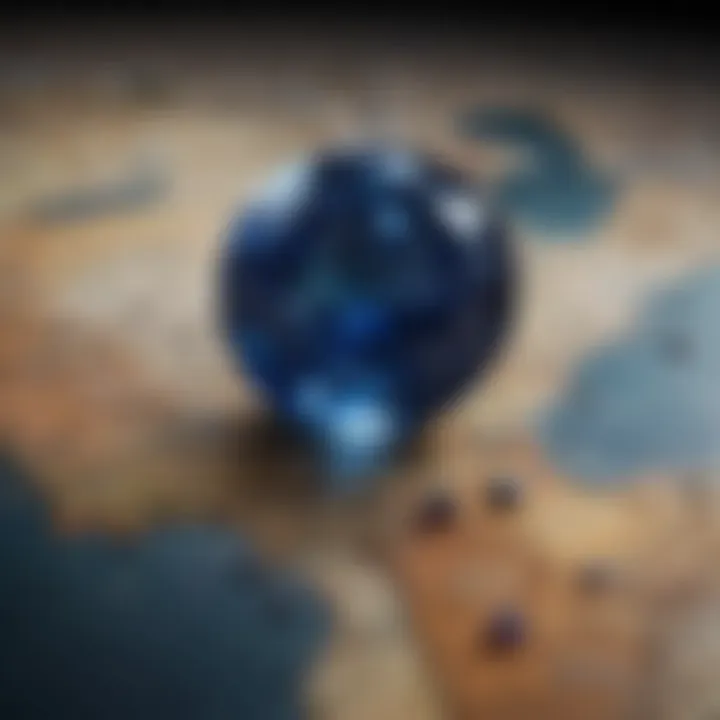
Representation in Art
In visual art, sapphire often symbolizes wisdom and nobility. Artists frequently include sapphires in portraits of aristocrats and royalty, emphasizing their wealth and status. For instance, in historical paintings, the depiction of sapphires within jewelry or crowns suggests power and reverence. The stone's vivid blue tone draws the eye and commands attention, making it perfect for highlighting important figures. Artists use sapphire as a motif, embodying the virtues of tranquility and insight.
Art movements such as Réalisme and Impressionism also adopted sapphire imagery, sometimes portraying the stone in still life. Depictions of vibrant sapphires draw attention to luxury and opulence. The way light interacts with the surface of sapphires creates captivating reflections, adding to their allure in visual art.
Moreover, sapphire's role doesn't end with visual representation. Many contemporary artists also explore the metaphysical aspects of the stone, challenging viewers to consider its deeper significance beyond mere beauty.
Sapphire in Poetry and Prose
In literature, sapphires are often associated with themes of love, fidelity, and wisdom. Poets frequently employ sapphire imagery to convey profound emotions. For example, William Blake described a sapphire's rich blue hue as emblematic of God's favor, suggesting divinity and purity.
Sapphire has been utilized by authors to symbolize the unbreakable bonds of love. Characters bearing sapphire jewelry may be portrayed as loyal and trustworthy, resonating with an audience's understanding of commitment. These gems convey messages of hope and enlightenment, indicating clarity of thought and the pursuit of knowledge.
Additionally, the gem's historical relevance adds depth to its literary symbolism. References to sapphires in ancient texts often highlight their spiritual significance, connecting humans to the divine. Writers leverage this ancient wisdom to enrich their narratives and provide layers of meaning.
"In exploring meanings, sapphire transcends mere ornamentation, becoming a vessel for emotions, wisdom, and connections through time."
Through both visual art and literature, sapphire continues to inspire. Its multifaceted presence in creative expressions speaks to the timeless allure of this remarkable stone.
Current Trends in Sapphire
The realm of sapphire is ever-evolving, reflecting shifts in consumer preferences, technological advancements, and global market dynamics. In this section, we will delve into how demand drives the market and the various innovations that shape the treatment of this precious stone. Understanding these trends helps to clarify the ongoing appeal of sapphire in both jewelry and technological applications.
Market Demand and Value
The sapphire market has seen notable fluctuations in demand, influenced by factors such as economic conditions, celebrity endorsements, and changing consumer behaviors. Today, consumers seek unique and ethically sourced gemstones. This trend aligns with a broader movement towards responsible purchasing, which has gained momentum across various industries.
As a result, the price of sapphires can vary significantly based on color, clarity, and origin. Exceptional specimens, particularly those with deep blue hues from Kashmir or vibrant yellows from Sri Lanka, command premium prices. Collectors and investors are particularly interested in high-quality stones, leading to increased demand in elite marketplaces.
Sapphires are also becoming popular choices for engagement rings as couples look towards non-traditional gems. This diversifies the consumer base, as younger generations are more inclined to opt for unique stones rather than standard diamonds. The direction of market demand suggests that sapphires will continue to hold significant value, enhancing their long-term investment appeal.
Innovations in Sapphire Treatment
Technological advancements have also transformed how sapphires are treated before they reach consumers. Treatments such as heating and diffusion are standard practices, enhancing color and clarity.
- Heating: This process intensifies the sapphire’s color and improves transparency. Most sapphires undergo this type of treatment, and the practice is widely accepted in the industry.
- Diffusion: This treatment involves the infusion of color into the sapphire using heat. It allows stones to exhibit vibrant colors at a lower cost.
Recent innovations involve more sophisticated methods that aim to increase the number of stones that exhibit desirable characteristics without compromising their integrity. As these advancements occur, consumers are encouraged to research the treatments applied to their sapphires, understanding which methods maintain the stone’s natural beauty.
Overall, as consumers become more informed, the distinction between treated and untreated stones is becoming more crucial.
"Sapphire continues to evolve, a blend of nature's beauty and human ingenuity, appealing to the moral preferences of today's discerning buyer."
The sapphire industry stands at the intersection of tradition and innovation, making it a fascinating subject for enthusiasts and investors alike.
Closure
The conclusion plays a vital role in synthesizing the rich information about sapphire presented throughout this article. The preceding sections have detailed not only the physical characteristics and history of this remarkable gemstone but also its cultural significance and metaphysical properties. By summarizing the key points, readers can gain a concise understanding of why sapphire continues to be revered across various disciplines.
Recap of Key Points
Sapphire is more than just a stone; it embodies a legacy that spans centuries. Here are the primary themes discussed:
- Physical Attributes: The durability, color variations, and chemical composition are fundamental in defining the sapphire.
- Historical Significance: From ancient civilizations to modern royalty, sapphires have held a place of honor and authority.
- Cultural Importance: The symbolism of love and wisdom reflects sapphire's role in various cultures and spiritual practices.
- Geographic Origins: Key-producing countries have their own unique sapphire mining practices that impact ethical sourcing.
- Metaphysical Properties: The psychological benefits associated with sapphires add a layer of depth to its allure.
- Popular Uses: The usage of sapphires in jewelry and technology showcases their practical and artistic appeal.
- Literary and Artistic Representation: Sapphires appear in various forms of expression, highlighting their continuing relevance.
- Current Trends: The evolving market and innovative treatments keep sapphires at the forefront of interest.
By encapsulating these elements, it becomes evident that sapphires are remarkable not just for their beauty but for their wide-ranging implications in human history and culture.
The Enduring Allure of Sapphire
Sapphire’s allure persists across generations, captivating gemstone enthusiasts, collectors, and jewelry designers alike. It's the combination of beauty, durability, and symbolism that makes this stone timeless. Sapphires can symbolize various virtues depending on the context, including loyalty, nobility, and integrity.
In contemporary jewelry design, sapphires maintain a prominent position. They often serve as a centerpiece in engagement rings or other significant pieces, denoting a sense of commitment and love. The technological applications of sapphire, such as in watches and smartphones, exemplify its versatility.
The sapphire’s multifaceted legacy endures, signifying more than just mere aesthetics; it represents trust, wisdom, and the pursuit of excellence.
In summary, the sapphire shines brightly not only due to its brilliance but also because of its profound impact on culture, history, and human connection. Its enduring nature ensures that it will continue to fascinate and inspire future generations.



